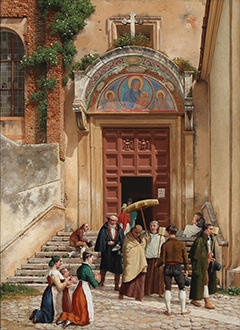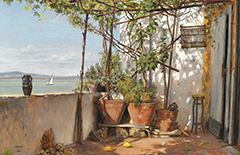The Wanderlust of the Danish Golden Age Painters



There is no doubt that the Danish Golden Age is one of the richest periods in Danish art history. In Denmark, the first half of the 1800s was characterized by a thriving artistic and intellectual life in spite of the disastrous historic events of the period, such as the bombardment of Copenhagen in 1801, the loss of the fleet in 1807, the national bankruptcy in 1813 and the cession of Norway in 1814. The nation was in need of a recovery, and this need formed the basis for some of the most significant Danish literary and artistic works ever created.
Artistic Vision
The Golden Age artists focused on a number of specific subjects, including the sea, ships, landscapes, figure studies and not least depictions from southern Europe. The artists had an international outlook and a great urge to travel. As part of their artistic training many of the artists travelled to southern Europe to find inspiration. Based on their experiences during their travels abroad they created some of the most famous artwork of the Golden Age.
Rome As a Centre for Art
Among the favourite destinations was Rome, which in the first half of the 1800s was still Europe's centre for art. In contrast to the time period’s rapid developments in other large cities, such as London and Paris, Rome maintained an air of rural bliss due to the Pope’s conservative rule. The special atmosphere seemed to appeal to the Danish artists, who with an open mind settled down to study the art and architecture of antiquity and find new sunlit subjects to incorporate in their repertoires.
The Auction's Italian Motifs
One of the Danish Golden Age painters who went to study in Rome was C. W. Eckersberg (1783-1853). He lived in the city from 1813-16, and included in the auction is a view of the Tiber from Trastevere in the painting "Castel St. Angelo" and a motif from an entrance to the church of Santa Maria in Aracoeli on the Capitol, where monks are on their way to see to a sick person.
Martinus Rørbye (1803-48) made several trips to Italy throughout his life and the painting "Loggia of Procida" from 1835 appears with the sea, the southern lights, lemons and a bird in a cage as a wonderful testimony to the Golden Age artists’ depiction and perception of Italy and of their tightly constructed motifs thereof. With Rørbye we also travel to the Amalfi Coast in a painting from 1835 depicting a rocky coast at Sorrento.
The landscape painter Fritz Petzholdt (1805-38) is perhaps not nearly as well known, but he too was, as most of the other Golden Age painters, a pupil of Eckersberg. In the years between 1830-36 he journeyed through Europe, including Italy. He was inspired by foreign landscape paintings, and included in the auction is the work "View from Villa d'Este at Tivoli" from 1834.
Come join us in the southern sun with the Danish Golden Age painters!
Auction: Tuesday, 28 February at 4 pm in Bredgade 33 in Copenhagen
Preview: 23-27 February at the same address
View the selection of fine art
View all the lots of auction 870
For further information, please contact:
Julie Arendse Voss: +45 8818 1123 · jav@bruun-rasmussen.dk
Birte Stokholm: +45 8818 1122 · bst@bruun-rasmussen.dk